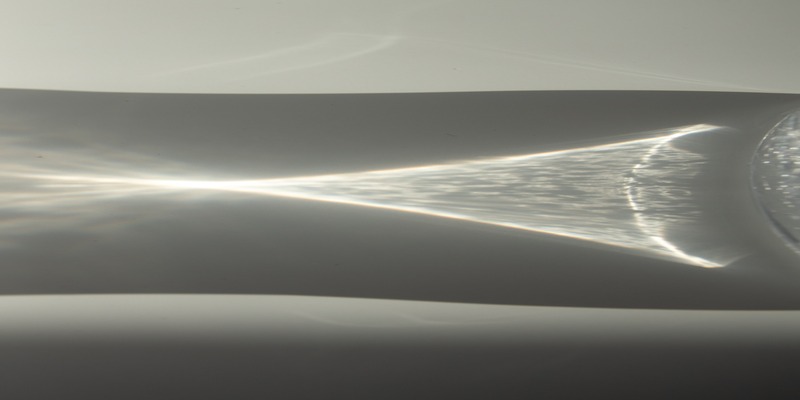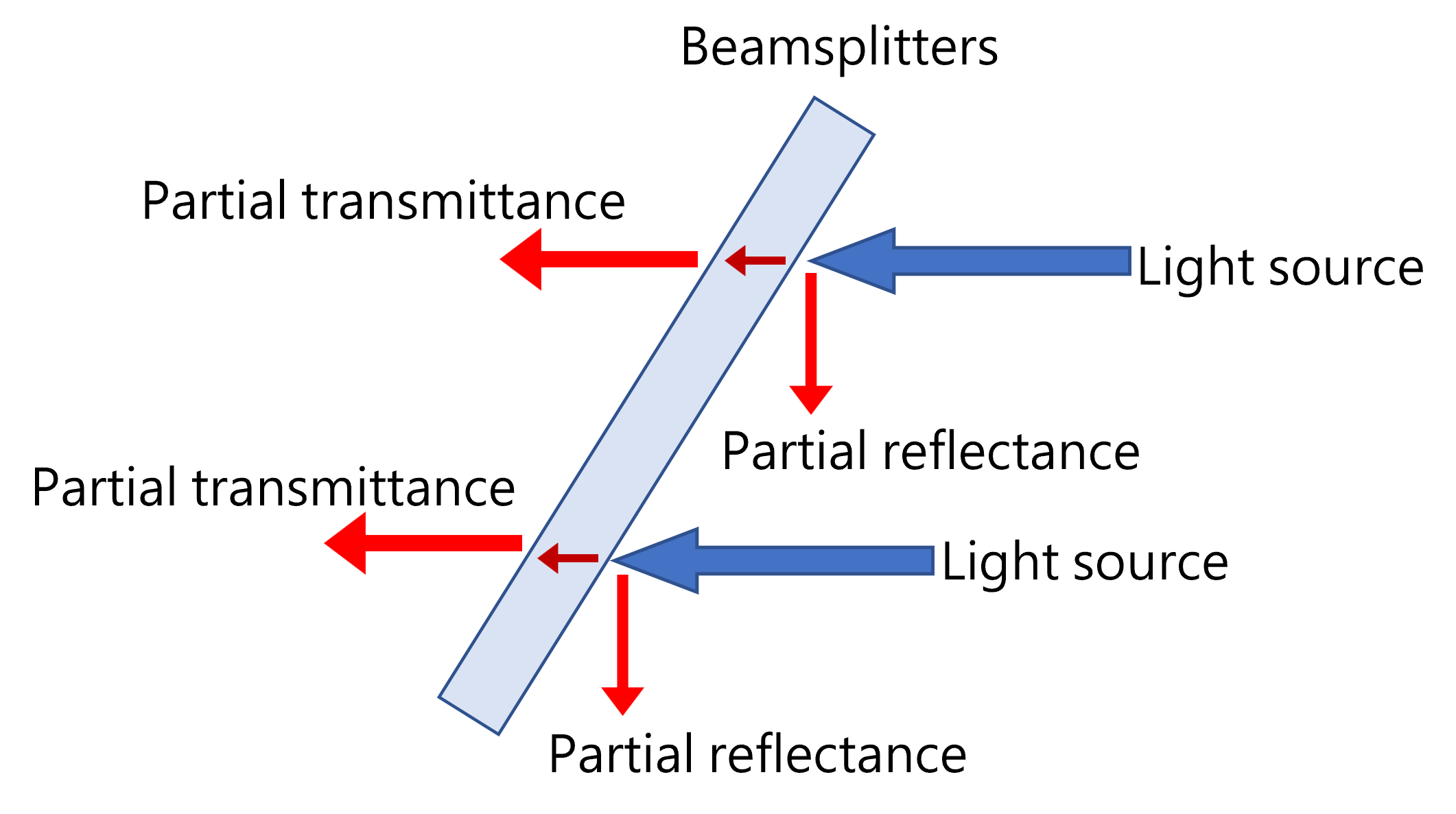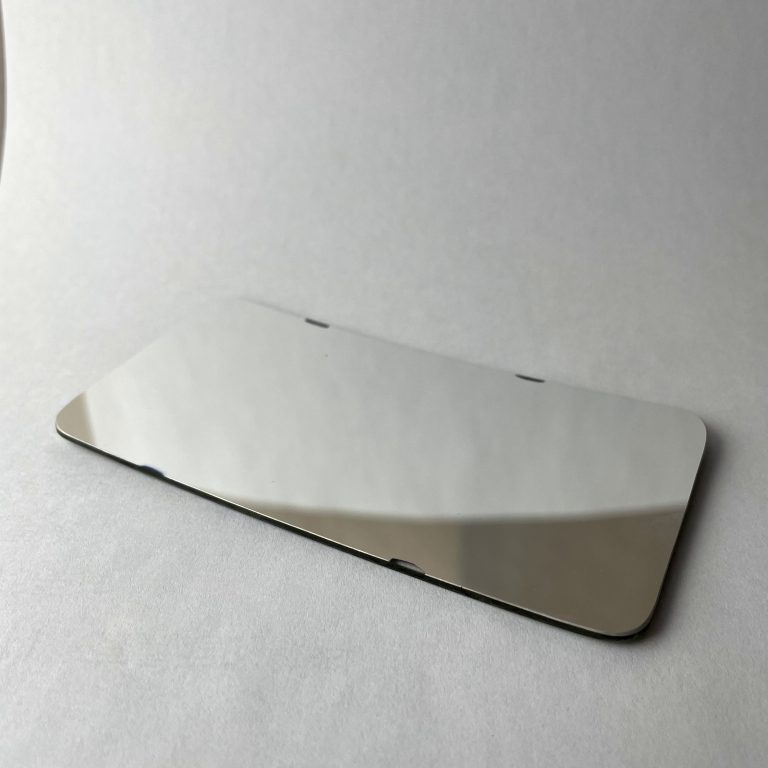- Home
- Blog
- Optical Coating
- Beamsplitters Guide: Principles, Types, and Applications
Beamsplitters Guide: Principles, Types, and Applications

A beamsplitter is an optical component that splits transmitted light and reflected light at a determined split ratio. Beamsplitters are used in a variety of optical equipment and play an important role in various industries. In this article, we will explain the principles, types, and applications of beamspliters while introducing our related products to give you a better understanding of beamsplitters.
What are Beamsplitters?
A beamsplitter is an optical component that splits incident light into transmitted light and reflected light. Polyester, polyurethane, or epoxy adhesives are used for the bonding surfaces of beamsplitters. Different adhesive thicknesses will affect transmit light and reflect light. A beamsplitter can also recombine two split lights into one beam .
〈Read more:What is the Principle of Optical Coatings?〉
How Does a Beamsplitter Work?
A beamsplitter is deposited with a dielectric film consisting of multiple layers. When light enters the beamsplitter, the light will be reflected or transmitted, and the total of the light reflectance and transmittance will be nearly 100%. Beamsplitters can be made from different types of substrates and coating methods to achieve different properties.
Types of Beamsplitters
There are four types of beamsplitters including Non-Polarizing Plate Beamsplitters, Polarizing Plate Beamsplitters, Non-Polarizing Beamsplitters Cubes, and Polarizing Beamsplitters Cubes. From here, we will explain the differences between these four types of beamsplitters.
Plate Beam Splitters
Non-Polarizing Plate Beamsplitters
Non-polarizing plate beamsplitters cover a wavelength range from the UV radiation to the IR radiation, mainly being designed for UV and IR applications. UV beamsplitters range from 250~1700nm; IR beamsplitters range from 900~2600nm. Dielectric film is used to improve the performance and less sensitive to the polarization of the incident beam, resulting in a higher damage threshold, making non-polarizing plate beamsplitters suitable for laser applications. Non-polarizing plate beamsplitters also has better thermal stabilities and low wavefront distortion(LWD).
Polarizing Plate Beamsplitters
Polarizing plate beamsplitters can separate polarized light into orthogonal linear polarization states, P-polarized light and S-polarized light. P-polarized light is transmitted and S-polarized light is reflected at a 90 degree angle. Polarizer beamsplitters are highly accurate and can reduce LWD to achieve higher accuracy and precise parallelism.
Cube Beamsplitters
Non-Polarizing Beamsplitters Cubes
Non-polarizing beamsplitters include plate beamsplitters and cube beamsplitters. Cube beamsplitters have a greater precision, resulting in low wavefront distortion and precise parallelism. Non-polarizing beamsplitters are mainly used in laser applications since non-polarizing beamsplitters can equally split light into two beams without changing the polarization state. Non-polarizing cube beamsplitters have a metal dielectric coating on one side. The beam offset is very small and the light is splited at a certain ratio without changing the original polarization state, resulting in high stability and low wavefront distortion, making non-polarizing beamsplitters suitable for high precision product applications.
Polarizing Beamsplitters Cubes
Polarizing beamsplitters are designed with specific split ratios of transmittance and reflectance. S-polarized light is transmitted, while P-polarized light is reflected. Polarizing beamsplitters are designed for laser wavelengths so the effectiveness of a polarizing beamsplitter is limited by wavelength and the beam is accordingly split into P-polarized light and S-polarized light when passing through the multilayer coatings, whereas P-polarized light is transmitted and S-polarized light is reflected. Polarizing cube beamsplitters are suitable for high-power laser applications since the coatings does not contain any metals that help reduce the damage rate.
Pellicle beamsplitters
Pellicle beamsplitters are beamsplitters with a wide wavelength range (300~2400nm). They are characterized by the fact that they deter ghosting caused by multiple surface reflections, and the condensed light does not produce chromatic aberration, suitable for use in combining beams. Coated pellicle beamsplitters can generate equal path length beams because the membrane is only about 5um thick. The extremely thin membrane bonded to metal frame can eliminate multiple reflections and can be used in a wide range of wavelengths. However, since the membranes is extremely thin, pellicle beamsplitters must be handle with care to avoid damages.
Polka dot beamsplitters
Polka dot beamsplitters have dot patterns on the glass surface. The material of dot patterns is aluminum coating via vacuum deposition. Polka dot beamsplitters offer different split ratios in the wavelength range including visible light, IR radiation,and UV radiation. Light will be reflected by the aluminum-coated dots and transmitted through the uncoated areas of the beamsplitter.
Polka dot beamsplitters are very wavelength-sensitive and relatively insensitive to angle of incidence, making polka dot beamsplitters suitable for use in white light illumination applications.
Applications of Beamsplitters
Beamsplitters applications -Laser Applications
Beamsplitters play a central role in laser applications due to the low absorption and ability to separate a single laser beam into multiple individual beams. For example, beamsplitters are used in precision laser optical testing or industrial laser applications because they can split light at a specific wavelength into two or more beams.
For laser applications, the quality of the optical components used affects effectiveness and reliability; therefore, beamsplitters must meet strict accuracy or standards when used in harsh environments. However, the performance of laser beamsplitters will be affected by wavelength, polarization, and angle of incidence. Beamsplitters are essential optical components in laser applications because these factors can change the beamsplitter's transmission over time, and these factors must be taken into account during system maintenance and calibration. Beamsplitters are essential components that require precision maintenance.
Beamsplitters applications - Lighting Systems
Besides laser applications, beamsplitters that split the incident light into two or more beams at a determined split ratio play an important role in lighting systems. For example, in stage lighting, beamsplitters are used to divide the beam into multiple parts, creating stunning effects.
Beamsplitters applications -Fiber Optic Telecommunications
In the optical communications industry, beamsplitter applications are multifaceted and also important. For example, a passive optical network (PON) takes a single signal and splits it into multiple signals, operating without power supply, just as a household mirror can project an image without a power supply. Power supply is only required at the transmitting and receiving points. Data can be delivered to multiple endpoints from a single transmission point.
Passive optical network architectures include a core network and an access network. The core network refers to the long-distance backbone communications network. On the other hand, an access network refers to a network that connects telecommunications carriers to users. The core network utilizes wavelength division multiplexing (WDM) technology, while the access network utilizes beamsplitters and wavelength division multiplexing components.
〈Read more:What are the Different Types of Glass Processing and Glass Finishing?〉
Yang-En Tech’s Beamsplitters
Customized production of beamsplitters are available. We design the reflectance and transmittance according to customer needs, and coat the oblique side of the rectangular prism or apply a dielectric multilayer film that allows changing the split ratio of reflectance and transmittance. The total of the split ratios can be nearly to 100%. We offer customized, high-quality and high-precision beamsplitters based on customer requirements.

Beamsplitters example – Half mirrors
Half mirrors (beamsplitters that the reflected light and transmitted light are approximately 1:1) have a low absorption, and the split ratio of transmittance and reflectance can be set as needed (e.g. 30:70, 80:20, 20:80). Half mirrors are often used in head-up displays and can be made of glass or plastic.

〈Read more:The benefits of hydrophobic coating that you have to know!〉
Beamsplitters example – Screen protectors
We conduct dielectric multilayer film coatings on beamsplitters according to customer specifications, and these products are mainly used in laser applications, detection equipment, diagnostic imaging equipment, etc. As shown below, both reflectance and transmittance are 50%, and possible substrates include glass, PC, and PMMA. These beamsplitters are used for monitor dome covers, magic mirrors, display monitor protection panels, etc.
.png)
Conclusion
Beamspliters are used in everyday life and technology applications. YANG EN TECH CO., LTD. have over 15 years of experience in providing services including optical coating designs, optical filter manufacturing, glass processing/finishing, and all kinds of optical coatings. Should you have any requests for beamspliters, please do not hesitate to contact us!

